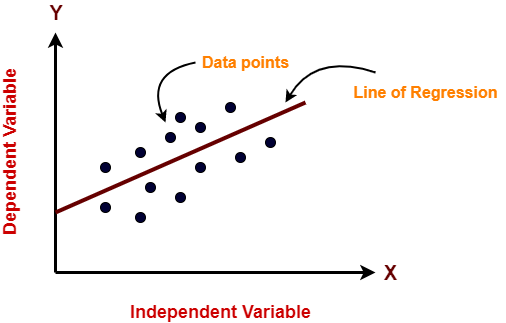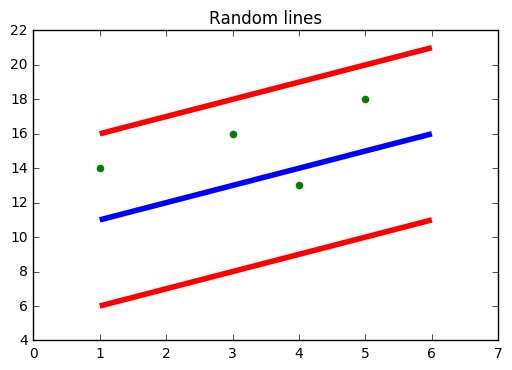In machine learning, regression algorithms play a pivotal role in modeling the relationship between a dependent variable and one or more independent variables. These powerful techniques enable data scientists and analysts to make accurate predictions of numerical values, shedding light on intricate patterns and trends within datasets.
Regression analysis is often used in finance, investing, and other fields, and it finds the relationship between a single dependent variable(target variable) and several independent ones. For example, predicting house prices, the stock market, or the salary of an employee, etc, are the most common
regression problems. This article will look at the 5 types of regression algorithms.
Learning Outcomes:
This article was published as a part of the Data Science Blogathon
Regression is a statistical method used in machine learning to model and analyze the relationships between a dependent variable (output) and one or more independent variables (inputs). It aims to predict the dependent variable’s value based on the independent variables’ values.
In machine learning, regression is a type of supervised learning in which the model learns from a dataset of input-output pairs. The model identifies patterns in the input features to predict continuous numerical values of the output variable. Regression algorithms help solve regression problems by finding the relationship between the data points and fitting a regression model.
Regression algorithms are a subset of machine learning algorithms that predict a continuous output variable based on one or more input features. Regression aims to model the relationship between the dependent variable (output) and one or more independent variables (inputs). These algorithms attempt to find the best-fit line, curve, or surface that minimizes the difference between predicted and actual values.
Regression algorithms are versatile tools used to predict continuous outcomes across various domains. Here are some detailed applications:
Here is a list of top 5 regression algorithms
Linear Regression is an ML algorithm used for supervised learning. It predicts a dependent variable(target) based on the given independent variable(s). This regression technique reveals a linear relationship between a dependent variable and the other given independent variables. Hence, the name of this algorithm is linear regression. It has two types: simple linear regression and multiple linear regression.

In the figure above, the independent variable is on the X-axis, and the output is on the Y-axis. The regression line is the best-fit line for a model, and our main objective in this algorithm is to find this best-fit line.
Pros:
Cons:
Tree models can be applied to all data containing numerical and categorical features. Decision trees are good at capturing the non-linear interaction between the features and the target variable. Decision trees somewhat match human-level thinking, so understanding the data is very intuitive.

Source: https://dinhanhthi.com
For example, if we classify how many hours a kid plays in particular weather, the decision tree looks somewhat like this above in the image.
So, in short, a decision tree is a tree where each node represents a feature, each branch represents a decision, and each leaf represents an outcome(numerical value regression).
Pros:
Cons:
Implementation
import numpy as np from sklearn.tree import DecisionTreeRegressor rng = np.random.RandomState(1) X = np.sort(5 * rng.rand(80, 1), axis=0) y = np.sin(X).ravel() y[::5] += 3 * (0.5 - rng.rand(16)) # Fit regression model regr = DecisionTreeRegressor(max_depth=2) regr.fit(X, y) # Predict X_test = np.arange(0.0, 5.0, 1)[:, np.newaxis] result = regr.predict(X_test) print(result) Output: [ 0.05236068 0.71382568 0.71382568 0.71382568 -0.86864256]
You must have heard about SVM, i.e., Support Vector Machine. SVR also uses the same idea as SVM, but it tries to predict the real values here. This algorithm uses hyperplanes to segregate the data. If this separation is impossible, it uses the kernel trick, where the dimension is increased, and then the data points become separable by a hyperplane.

Source: https://www.medium.com
In the figure above, the Blue line is the hyperplane; the Red Line is the Boundary Line.
All the data points are within the boundary line(Red Line). SVR’s main objective is to consider only those points within the boundary line.
Pros:
Cons:
Implementation
from sklearn.svm import SVR import numpy as np rng = np.random.RandomState(1) X = np.sort(5 * rng.rand(80, 1), axis=0) y = np.sin(X).ravel() y[::5] += 3 * (0.5 - rng.rand(16)) # Fit regression model svr = SVR().fit(X, y) # Predict X_test = np.arange(0.0, 5.0, 1)[:, np.newaxis] svr.predict(X_test)
Output: array([-0.07840308, 0.78077042, 0.81326895, 0.08638149, -0.6928019 ])
LASSO stands for Least Absolute Selection Shrinkage Operator is one of the simplest classification algorithm. Shrinkage is a constraint on attributes or parameters. This classification algorithm operates by finding and applying a constraint on the model attributes that causes the regression coefficients for some variables to shrink toward zero. Variables with a regression coefficient of zero are excluded from the model.
So, lasso regression analysis is a shrinkage and variable selection method that helps to determine which predictors are most important.
Pros:
Cons:
Implementation
from sklearn import linear_model import numpy as np rng = np.random.RandomState(1) X = np.sort(5 * rng.rand(80, 1), axis=0) y = np.sin(X).ravel() y[::5] += 3 * (0.5 - rng.rand(16)) # Fit regression model lassoReg = linear_model.Lasso(alpha=0.1) lassoReg.fit(X,y) # Predict X_test = np.arange(0.0, 5.0, 1)[:, np.newaxis] lassoReg.predict(X_test)
Output: array([ 0.78305084, 0.49957596, 0.21610108, -0.0673738 , -0.35084868])
Random Forests are an ensemble(combination) of decision trees. They are a Supervised Learning algorithm used for classification and regression. The input data is passed through multiple decision trees. The algorithm executes by constructing a different number of decision trees at training time and outputting the class, that is, the mode of the classes (for classification) or mean prediction of the individual trees.
Source: https://levelup.gitconnected.com
Pros:
Cons:
Implementation
from sklearn.ensemble import RandomForestRegressor from sklearn.datasets import make_regression X, y = make_regression(n_features=4, n_informative=2, random_state=0, shuffle=False) rfr = RandomForestRegressor(max_depth=3) rfr.fit(X, y) print(rfr.predict([[0, 1, 0, 1]])) Output: [33.2470716]
Regression algorithms are indispensable tools in the data science arsenal. They enable researchers and practitioners to unravel the intricate relationships between variables and make informed predictions. From linear regression’s simplicity to the versatility of ensemble methods, these techniques equip analysts with diverse approaches to tackle a wide range of regression problems.
However, the effectiveness of regression algorithms hinges on careful feature engineering, data preprocessing, and model selection. Metrics such as mean squared error (MSE), root mean squared error (RMSE), and R-squared serve as critical benchmarks for evaluating model performance and guiding the iterative optimization process.
As data sources grow in size and complexity, developing more sophisticated regression algorithms will remain a focal point for the machine-learning community. By leveraging the power of regression analysis, researchers and practitioners can unlock valuable insights, drive informed decision-making, and push the boundaries of predictive analytics across diverse domains.
The media shown in this article are not owned by Analytics Vidhya and is used at the Author’s discretion.
A. Examples of regression algorithms include Linear Regression, Polynomial Regression, Ridge Regression, Lasso Regression, Elastic Net Regression, Support Vector Regression (SVR), Decision Tree Regression, Random Forest Regression, and Gradient Boosting Regression. These algorithms are used to predict continuous numerical values and are widely applied in various fields such as finance, economics, and engineering.
A. Regression algorithms are used to predict continuous numerical values based on input features. They are widely applied in various fields, such as finance for stock price forecasting, economics for predicting economic indicators, healthcare for disease progression estimation, and engineering for product performance prediction. Regression analysis helps uncover relationships between variables and make informed predictions for future data points.
A. The commonly used algorithm for linear regression is Ordinary Least Squares (OLS). OLS finds the best-fitting line by minimizing the sum of the squared differences between the observed values and the predicted values. This results in a linear equation that best describes the relationship between the dependent and independent variables.
A. Linear regression predicts continuous outcomes and models a linear relationship between the dependent and independent variables. Logistic regression, on the other hand, is used for binary classification problems and models the probability of a binary outcome using a logistic function, resulting in outputs between 0 and 1.
Lorem ipsum dolor sit amet, consectetur adipiscing elit,
I really enjoyed this post! It was informative and I learned a lot. Thank you for writing it.